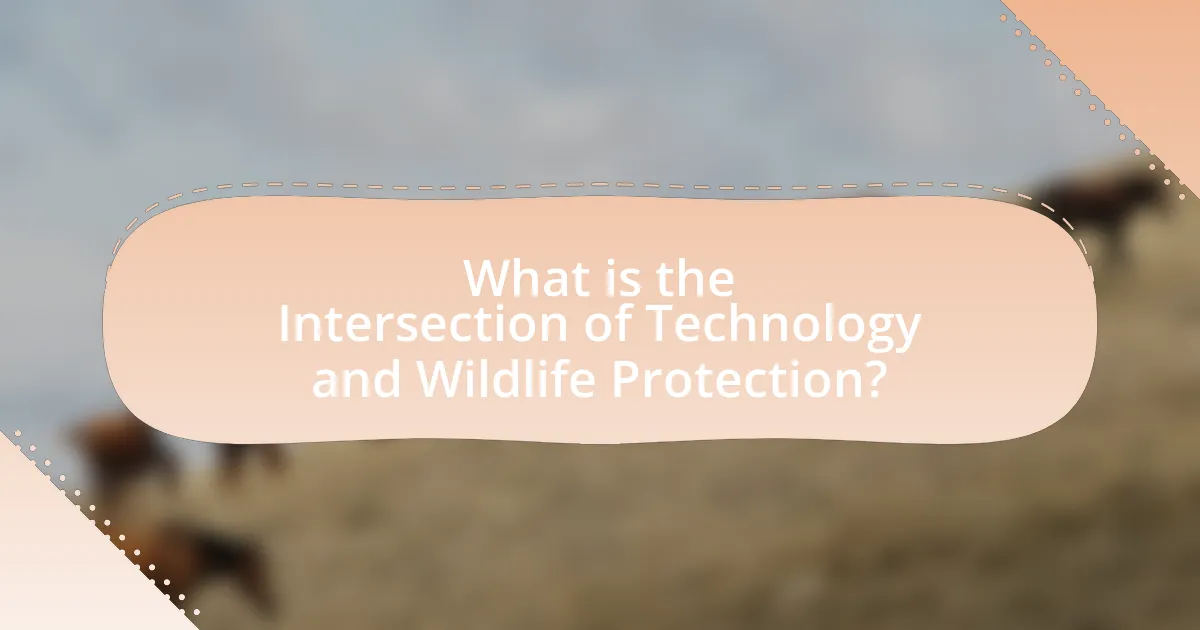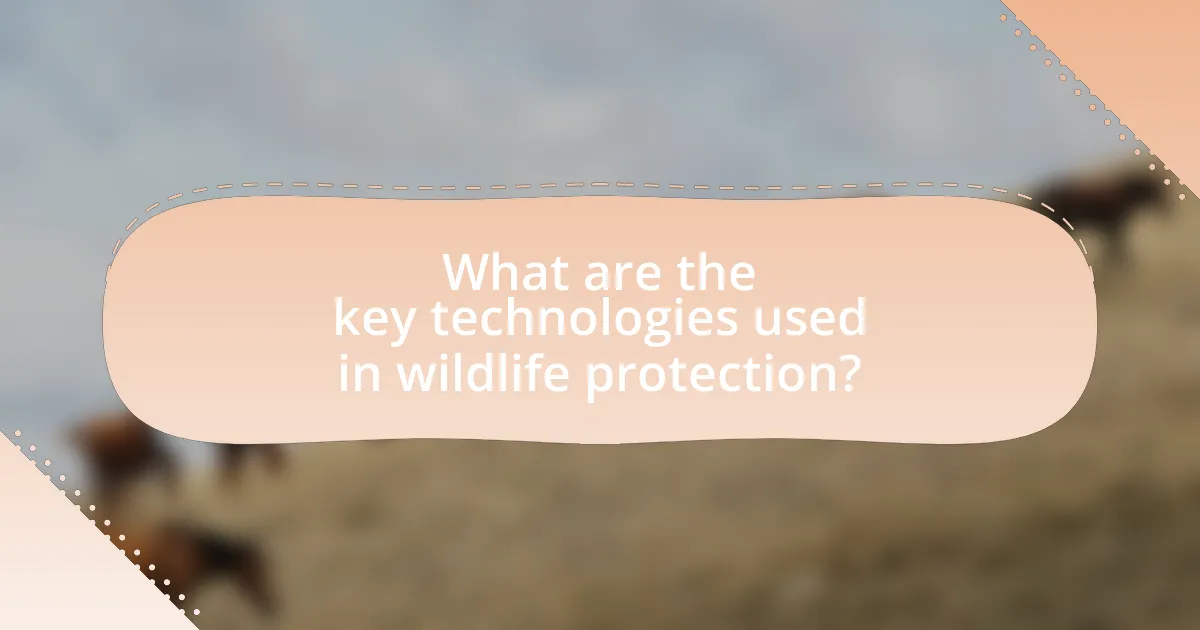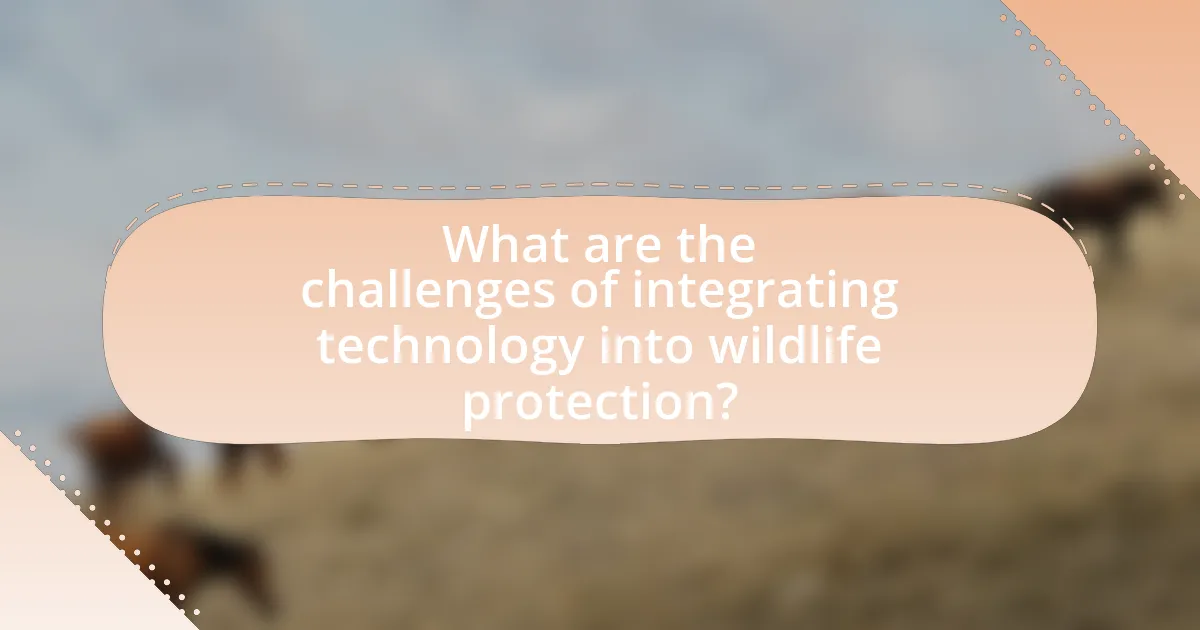The article focuses on the intersection of technology and wildlife protection, highlighting how advanced tools such as satellite tracking, drones, and artificial intelligence are utilized to conserve and monitor wildlife populations and their habitats. It discusses the contributions of these technologies to effective conservation strategies, including real-time monitoring, data collection, and anti-poaching efforts. Key technologies like camera traps and genetic analysis are examined for their roles in enhancing wildlife protection. The article also addresses the challenges and ethical concerns associated with integrating technology into conservation efforts, emphasizing the importance of collaboration among stakeholders for successful implementation.

What is the Intersection of Technology and Wildlife Protection?
The intersection of technology and wildlife protection involves the use of advanced tools and methods to conserve and monitor wildlife populations and their habitats. Technologies such as satellite tracking, drones, and camera traps enable researchers to gather data on animal movements, population dynamics, and habitat use, which are crucial for effective conservation strategies. For instance, a study published in the journal “Conservation Biology” highlights how GPS collars have improved the understanding of migratory patterns in endangered species, leading to better management practices. Additionally, artificial intelligence is increasingly being utilized to analyze large datasets, helping to identify poaching hotspots and predict illegal activities, thereby enhancing anti-poaching efforts.
How does technology contribute to wildlife protection?
Technology contributes to wildlife protection by enabling advanced monitoring, data collection, and conservation strategies. For instance, satellite tracking and GPS collars allow researchers to monitor animal movements and behaviors in real-time, providing critical data for understanding migration patterns and habitat use. Additionally, drones are increasingly used for aerial surveys, enabling conservationists to assess wildlife populations and detect poaching activities over large areas efficiently. According to a study published in the journal “Conservation Biology,” the use of camera traps has significantly improved the ability to monitor elusive species, leading to better-informed conservation efforts. Furthermore, machine learning algorithms analyze vast amounts of ecological data, helping predict threats to wildlife and optimize conservation resources. These technological advancements collectively enhance the effectiveness of wildlife protection initiatives.
What types of technology are used in wildlife conservation?
Various types of technology are used in wildlife conservation, including satellite tracking, drones, camera traps, and genetic analysis. Satellite tracking allows researchers to monitor animal movements and behaviors in real-time, providing critical data for conservation efforts. Drones are utilized for aerial surveys and habitat assessments, enabling efficient monitoring of large areas that are difficult to access. Camera traps capture images of wildlife, helping to estimate population sizes and study species behavior without human interference. Genetic analysis aids in understanding genetic diversity and population health, which is essential for effective management strategies. These technologies collectively enhance the ability to protect and conserve wildlife effectively.
How do these technologies enhance monitoring and data collection?
Technologies enhance monitoring and data collection by providing real-time data, improving accuracy, and enabling remote access to wildlife information. For instance, GPS collars and camera traps allow researchers to track animal movements and behaviors without human interference, leading to more reliable data. A study published in the journal “Ecological Applications” demonstrated that GPS tracking improved the understanding of migratory patterns in endangered species, resulting in better conservation strategies. Additionally, drones equipped with sensors can cover large areas quickly, collecting data on habitat conditions and wildlife populations, which traditional methods may miss. This integration of technology not only streamlines data collection but also enhances the overall effectiveness of wildlife protection efforts.
Why is wildlife protection important in the context of technology?
Wildlife protection is crucial in the context of technology because technological advancements can both threaten and enhance conservation efforts. For instance, technologies such as satellite tracking and drones enable real-time monitoring of endangered species and their habitats, significantly improving data collection and response strategies. According to a study published in the journal “Conservation Biology,” the use of drones has increased the efficiency of wildlife surveys by up to 80%, allowing for better resource allocation and protection measures. Additionally, technology facilitates anti-poaching efforts through the use of smart collars and automated surveillance systems, which have been shown to reduce poaching incidents by 50% in certain regions. Thus, integrating technology into wildlife protection strategies is essential for effective conservation and the preservation of biodiversity.
What are the main threats to wildlife that technology can address?
The main threats to wildlife that technology can address include habitat destruction, poaching, climate change, and invasive species. Technology such as satellite imagery and drones can monitor habitat changes and illegal activities, providing real-time data to conservationists. For instance, the use of drones has been shown to reduce poaching incidents by up to 80% in certain regions, as reported by the World Wildlife Fund. Additionally, climate modeling tools help predict the impacts of climate change on species, allowing for proactive conservation strategies. Furthermore, technology like genetic analysis can identify and manage invasive species, thereby protecting native wildlife.
How does technology help in combating poaching and illegal trade?
Technology aids in combating poaching and illegal trade through advanced monitoring systems, data analytics, and communication tools. For instance, satellite imagery and drones enable real-time surveillance of wildlife habitats, allowing authorities to detect poaching activities promptly. Additionally, data analytics can identify patterns in poaching incidents, helping law enforcement allocate resources more effectively. Furthermore, mobile applications facilitate communication between rangers and local communities, enhancing reporting of suspicious activities. According to a study by the World Wildlife Fund, the use of technology has led to a 30% reduction in poaching incidents in certain protected areas, demonstrating its effectiveness in wildlife protection efforts.

What are the key technologies used in wildlife protection?
Key technologies used in wildlife protection include satellite tracking, drones, camera traps, and artificial intelligence. Satellite tracking enables real-time monitoring of animal movements, which helps in understanding migration patterns and habitat use. Drones are utilized for aerial surveillance, allowing for the assessment of remote areas and the detection of poaching activities. Camera traps provide valuable data on wildlife populations and behaviors by capturing images of animals in their natural habitats. Artificial intelligence analyzes large datasets from these technologies to identify trends and predict potential threats, enhancing conservation efforts. These technologies collectively improve the effectiveness of wildlife protection strategies and contribute to biodiversity conservation.
How do drones assist in wildlife conservation efforts?
Drones assist in wildlife conservation efforts by providing aerial surveillance and data collection capabilities that enhance monitoring and protection of endangered species and their habitats. These unmanned aerial vehicles can cover large areas quickly, allowing conservationists to track animal movements, assess habitat conditions, and detect poaching activities in real-time. For instance, a study published in the journal “Conservation Biology” demonstrated that drones improved the detection of illegal activities by 80% compared to traditional ground patrols, showcasing their effectiveness in enhancing conservation strategies.
What are the advantages of using drones for monitoring wildlife?
Drones provide significant advantages for monitoring wildlife, including enhanced data collection, reduced human disturbance, and improved accessibility to remote areas. These unmanned aerial vehicles can capture high-resolution images and videos, allowing researchers to gather detailed information on animal populations and behaviors without intruding on their natural habitats. For instance, a study published in the journal “Remote Sensing” demonstrated that drones could effectively monitor elephant populations in Africa, providing accurate counts and behavioral insights while minimizing stress on the animals. Additionally, drones can access difficult terrains, such as dense forests or rugged mountains, where traditional monitoring methods may be impractical or dangerous, thus expanding the scope of wildlife research and conservation efforts.
How do drones improve data accuracy in wildlife studies?
Drones improve data accuracy in wildlife studies by providing high-resolution aerial imagery and real-time data collection. This technology allows researchers to monitor animal populations, track movements, and assess habitat conditions with greater precision than traditional methods. For instance, a study published in the journal “Remote Sensing” demonstrated that drone surveys could achieve up to 90% accuracy in counting wildlife compared to ground-based surveys, which often suffer from visibility issues and human error. By utilizing drones, researchers can cover large areas quickly and gather consistent data, leading to more reliable insights into wildlife behavior and conservation needs.
What role does artificial intelligence play in wildlife protection?
Artificial intelligence plays a crucial role in wildlife protection by enhancing monitoring, data analysis, and decision-making processes. AI technologies, such as machine learning and computer vision, enable the analysis of vast amounts of data from camera traps, drones, and satellite imagery, allowing for real-time tracking of wildlife populations and their habitats. For instance, a study published in the journal “Nature” demonstrated that AI algorithms could identify individual animals from images with over 90% accuracy, significantly improving species monitoring efforts. Additionally, AI can predict poaching activities by analyzing patterns in historical data, which helps conservationists allocate resources more effectively. These applications illustrate how AI is transforming wildlife protection strategies, making them more efficient and data-driven.
How can AI analyze data to predict wildlife behavior?
AI can analyze data to predict wildlife behavior by utilizing machine learning algorithms to process large datasets from various sources, such as GPS tracking, camera traps, and environmental sensors. These algorithms identify patterns and correlations in the data, enabling predictions about animal movements, feeding habits, and breeding cycles. For instance, a study published in the journal “Ecology and Evolution” demonstrated that AI models could accurately forecast the migration patterns of elephants by analyzing historical movement data alongside environmental variables. This predictive capability enhances conservation efforts by allowing wildlife managers to anticipate changes in animal behavior and implement timely interventions.
What are the applications of AI in identifying endangered species?
AI is applied in identifying endangered species through techniques such as image recognition, acoustic monitoring, and data analysis. Image recognition algorithms analyze photographs from camera traps to detect and classify species, enabling researchers to monitor populations and distribution. Acoustic monitoring utilizes AI to process sound recordings, identifying species based on their calls, which is particularly useful for elusive or nocturnal animals. Additionally, AI-driven data analysis integrates various ecological data sources, enhancing the understanding of species’ habitats and threats, thus informing conservation strategies. These applications have been validated in studies, such as the use of convolutional neural networks for species identification in camera trap images, demonstrating high accuracy rates in recognizing endangered species.

What are the challenges of integrating technology into wildlife protection?
Integrating technology into wildlife protection faces several challenges, including high costs, technical limitations, and ethical concerns. High costs can hinder the adoption of advanced technologies, such as drones and satellite tracking systems, which may require significant financial investment for both initial setup and ongoing maintenance. Technical limitations arise from the need for reliable data collection and analysis, as many remote areas lack adequate infrastructure for technology deployment. Ethical concerns include the potential for invasive monitoring practices that may disrupt animal behavior or infringe on local communities’ rights. These challenges must be addressed to effectively leverage technology in wildlife conservation efforts.
What are the limitations of current wildlife protection technologies?
Current wildlife protection technologies face several limitations, including high costs, limited accessibility, and insufficient data accuracy. High costs hinder the widespread adoption of advanced technologies like drones and satellite tracking, making them inaccessible for many conservation organizations. Limited accessibility to remote areas restricts the effectiveness of these technologies in monitoring wildlife populations. Additionally, insufficient data accuracy from sensors and tracking devices can lead to misinterpretations of animal behavior and habitat use, ultimately undermining conservation efforts. For instance, studies have shown that GPS collars can have a margin of error that affects the reliability of tracking data, complicating management decisions.
How do costs affect the implementation of technology in conservation?
Costs significantly impact the implementation of technology in conservation by determining the feasibility and scale of projects. High initial investments in technology, such as drones for monitoring wildlife or advanced data analytics systems, can limit the ability of conservation organizations to adopt these tools, especially in regions with constrained budgets. For instance, a study by the World Wildlife Fund indicated that the cost of implementing satellite tracking for endangered species can exceed $10,000 per animal, which can be prohibitive for many conservation efforts. Additionally, ongoing maintenance and operational costs can further strain financial resources, leading to prioritization of less effective, traditional methods over innovative technological solutions.
What ethical concerns arise from using technology in wildlife protection?
The ethical concerns arising from using technology in wildlife protection include issues of privacy, consent, and potential harm to animal welfare. The deployment of surveillance technologies, such as drones and camera traps, raises questions about the invasion of natural habitats and the stress it may cause to wildlife. Additionally, the use of tracking devices can lead to ethical dilemmas regarding the autonomy of animals, as these devices may alter their behavior or expose them to risks. Furthermore, the reliance on technology can create disparities in conservation efforts, where certain species receive more attention than others, potentially neglecting less charismatic or less visible species. These concerns highlight the need for a balanced approach that considers both technological benefits and ethical implications in wildlife conservation efforts.
How can collaboration enhance the effectiveness of technology in wildlife protection?
Collaboration enhances the effectiveness of technology in wildlife protection by pooling resources, expertise, and data from various stakeholders, including governments, NGOs, and local communities. This collective effort leads to the development of more comprehensive and adaptive technological solutions, such as advanced tracking systems and data analytics platforms. For instance, the partnership between the World Wildlife Fund and tech companies has resulted in the use of satellite imagery and drones to monitor endangered species and their habitats more effectively. Such collaborations not only improve the accuracy of wildlife monitoring but also facilitate rapid response to threats, as seen in the successful anti-poaching initiatives in Africa that leverage shared intelligence and technology.
What partnerships are essential for successful technology deployment?
Successful technology deployment in wildlife protection requires partnerships between technology developers, conservation organizations, governmental agencies, and local communities. Technology developers provide innovative solutions, while conservation organizations ensure that these technologies align with ecological goals. Governmental agencies facilitate regulatory compliance and funding, and local communities offer insights and support for effective implementation. For instance, collaborations like the partnership between the World Wildlife Fund and tech companies have led to the development of tracking systems that enhance wildlife monitoring and protection efforts.
How can local communities be involved in technology-driven conservation efforts?
Local communities can be involved in technology-driven conservation efforts by participating in data collection, monitoring wildlife, and utilizing mobile applications for reporting environmental changes. For instance, community members can use smartphone apps to track animal populations and report illegal activities, which enhances real-time data availability for conservationists. A study by the World Wildlife Fund found that local engagement in conservation initiatives significantly improves the effectiveness of wildlife protection efforts, as communities often possess valuable knowledge about their ecosystems. This collaboration fosters a sense of ownership and responsibility towards local biodiversity, ultimately leading to more sustainable conservation outcomes.
What best practices should be followed when using technology for wildlife protection?
Best practices for using technology in wildlife protection include implementing real-time monitoring systems, utilizing drones for aerial surveys, and employing data analytics for habitat management. Real-time monitoring systems, such as camera traps and GPS collars, enable conservationists to track animal movements and behaviors, providing critical data for species protection. Drones facilitate efficient aerial surveys, allowing for the assessment of large areas without disturbing wildlife, which is essential for identifying poaching activities or habitat degradation. Data analytics can enhance habitat management by analyzing environmental changes and predicting the impacts of climate change on wildlife populations. These practices are supported by studies showing that technology significantly improves conservation outcomes, such as a 2019 report from the World Wildlife Fund indicating that drone surveillance reduced poaching incidents by up to 80% in certain regions.
How can organizations ensure the sustainability of technological solutions?
Organizations can ensure the sustainability of technological solutions by implementing a lifecycle approach that emphasizes eco-friendly design, efficient resource use, and ongoing maintenance. This approach involves assessing the environmental impact of technology from its inception to its disposal, ensuring that materials are recyclable or biodegradable, and optimizing energy consumption during operation. For instance, the Global e-Sustainability Initiative reports that adopting sustainable practices in technology can reduce carbon emissions by up to 30%. Additionally, organizations can engage in continuous monitoring and evaluation of their technological solutions to adapt to changing environmental standards and improve efficiency over time.
What strategies can be employed to educate stakeholders about technology in wildlife conservation?
To educate stakeholders about technology in wildlife conservation, targeted workshops and training sessions can be employed. These educational initiatives can provide hands-on experience with conservation technologies such as GPS tracking, camera traps, and data analysis software. Research indicates that interactive learning significantly enhances knowledge retention; for instance, a study published in the Journal of Wildlife Management found that participants in hands-on workshops demonstrated a 40% increase in understanding of technology applications in conservation compared to traditional lecture formats. Additionally, creating informative online platforms and resources can facilitate ongoing education, allowing stakeholders to access the latest technological advancements and case studies in wildlife conservation.